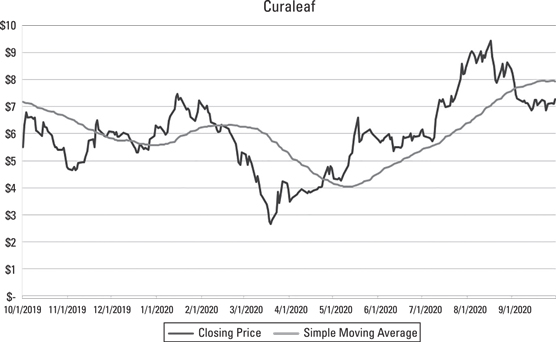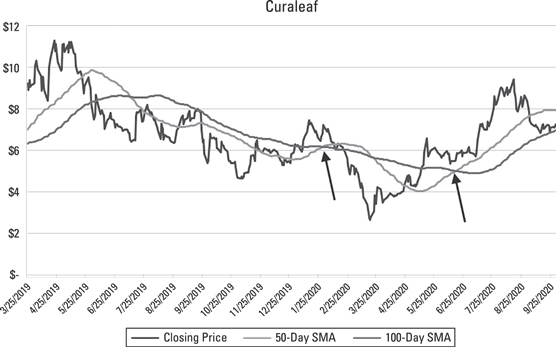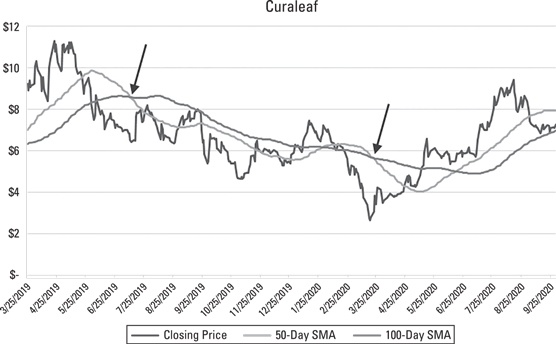Upward momentum
With momentum investing, you basically want to buy stocks that show sustainable upward momentum and sell them before the price starts to trend downward.The key word here is sustainable, which means you’re looking for a pattern that you have reason to believe will continue for the foreseeable future. One way to identify a stock with sustainable upward momentum is to look at its 50-day and 100-day simple moving averages in relation to one another.
A simple moving average (SMA) shows the change in a stock’s average price over a certain number of days. For example, to calculate the five-day SMA of a stock for a given day, you total the stock’s closing prices over the past five days and divide by five. To calculate the 50-day moving average, you total the stock’s closing prices over the past 50 days and divide by 50.
To create an SMA chart, you calculate the SMA for the desired period (for example, for each of the past 50 days) and plot those points on a chart, as shown. You end up with a line or curve that smooths out the daily fluctuations in the share price (which reduces the “noise”) to make the stock’s overall momentum clearer and easier to visualize and understand.
The good news is that you don’t have to calculate simple moving averages and chart them. Nearly every online broker features moving average charts as part of its service. I explained how to calculate the SMA and create a chart just so you would have a clearer understanding of how this investment strategy works.
 A 50-day moving average chart for Curaleaf
A 50-day moving average chart for CuraleafAs a momentum investor, you look for times when the short-term upward trend is strong enough to trigger a positive shift in the long-term trend. The most common way to spot such a shift is to chart a stock’s 50-day and 100-day moving averages and look for points where the two lines cross. When the 50-day SMA line moves from below to above the 100-day SMA line (see the following figure), this is a sign that the short-term trend may be strong enough to trigger an upward shift in the long-term momentum — a buy signal.
However, if you look at enough of these moving averages charts, you start to notice that this technique doesn’t always work. You’ll notice plenty of instances where the 50-day SMA line moves from below to above the 100-day SMA line that corresponds with a sell-off. Likewise, you’ll notice plenty of instances where the 50-day SMA line dives down below the 100-day SMA line corresponds to an upward shift in share price. In other words, don’t blindly follow this technique. Look for points where the 50-day SMA moves above the 100-day SMA.
Look for points where the 50-day SMA moves above the 100-day SMA.Momentum investors may examine the SMA over longer periods or use other types of charts to gauge a stock’s momentum and identify buy and sell opportunities, but this basic method enables you to wrap your head around the concept and try it if you so desire.
Be careful buying into an apparent rally, because short sellers can quickly inflate a stock’s price when they exit their positions in anticipation that the stock price will soon tank.
Downward momentum
After buying a cannabis stock with upward momentum, your next decision is when to sell it. At this point, monitoring the stock’s SMA is even more important, because at any time in the future, the trend can flip from upward to downward. You want to sell your stock as close to the stock’s peak as possible, and as you feel comfortable doing. As is commonly said among investors, “Pigs get fat, and hogs get slaughtered.” Don’t be too greedy when deciding the right time to sell.If you’re unsure whether a stock has peaked, consider cashing out your principle (the initial amount you invested) and riding to the top with your gains (the remaining shares). As you become more familiar with cannabis stocks, you may want to consider taking bigger risks. Deciding when and how much to sell depends on your personal risk tolerance and how much you can afford to and want to gamble.
Now, instead of looking for points where the 50-day SMA moves from below to above the line for the 100-day SMA, you want to watch for when that 50-day line crosses down from above to below the 100-day line (see Figure 13-3). How far that 50-day line dives down before you pull the trigger is up to you, but if you want to remain true to this strategy, the sooner you sell, the better. Sell when the 50-day SMA drops below the 100-day SMA.
Sell when the 50-day SMA drops below the 100-day SMA.
